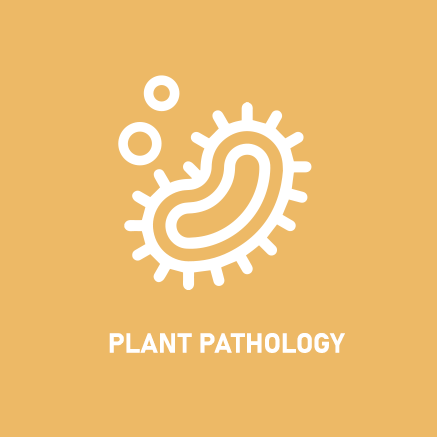Plant Pathology
DEPARTMENT OF PLANT PATHOLOGY

The main task of the department is to conduct research on the identification, biology, ecology and control of fungi and fungal-like organisms that cause crop diseases. In addition, diseases of ornamentals and other plants grown in urban areas as well as problems in forest pathology and plant diseases in natural reserves are also investigated. The development of plant protection technologies based on the use of fungicides and other methods and the application of microbes that may control plant pathogens and weeds as biocontrol agents are in focus, as well. Special attention is paid to the etiology and the epidemiology of apple scab, monilia and Phytophthora diseases, fusarioses, especially in relation to mycotoxin production, and diseases caused by powdery mildew and rust fungi. Molecular analyses are used to investigate the precise identification, phylogeny and intraspecific and interspecific variability of Fusarium, powdery mildew, Monilinia, Pyrenophora, Phytophthora and rust species as well as fungicide resistance in some plant pathogenic fungi.
STAFF
RESEARCH
PUBLICATIONS
Selected publications:
Legler SE, Pintye A, Caffi, T, Gulyás S, Bohár G, Rossi V, Kiss L (2016) Sporulation rate in culture and mycoparasitic activity, but not mycohost specificity, are the key factors for selecting Ampelomyces strains for biocontrol of grapevine powdery mildew (Erysiphe necator). Eur J Plant Pathol 144: 723-736. DOI: 10.1007/s10658-015-0834-1
Molnár O (2016) Fusarium proliferatum causing head blight on oat in Hungary. Eur J Plant Pathol (published online) DOI 10.1007/s10658-016-0940-8
Holb IJ, Füzi I (2016) Monitoring of ascospore density of Erysiphe necator in the air in relation to weather factors and powdery mildew development. Eur J Plant Pathol 144: 751-762. DOI:10.1007/s10658-015-0823-4
Pintye A, Ropars J, Harvey N, Shin H-D, Leyronas C, Nicot PC, Giraud T, Kiss L (2015) Host phenology and geography as drivers of differentiation in generalist fungal mycoparasites. PLoS ONE 10(3): e0120703. DOI: 10.1371/journal.pone.0120703
Almási A, Csilléry G, Csömör Z, Nemes K, Palkovics L, Salánki K, Tóbiás I (2015) Phylogenetic analysis of Tomato spotted wilt virus (TSWV) NSs protein demonstrates the isolated emergence of resistance-breaking strains in pepper Virus Genes 50: 71-78. doi:10.1007/s11262-014-1131-3
Jankovics T, Komáromi J, Fábián A, Jager K, Vida G, Kiss L (2015) New insights into the life cycle of the wheat powdery mildew: direct observation of ascosporic infection in Blumeria graminis f. sp. tritici. Phytopathology 105: 797-804. DOI: 10.1094/PHYTO-10-14-0268-R
Nemes K., Gellért Á, Balázs E, Salánki K (2014) Alanine scanning of Cucumber mosaic virus (CMV) 2b protein identifies different positions for cell-to-cell movement and gene silencing suppressor activity, PloS ONE 9: e112095. doi: 10.1371/journal.pone.0112095
Vági P, Knapp DG, Kósa A, Seress D, Horváth ÁN, Kovács GM (2014) Simultaneous specific in planta visualization of root-colonizing fungi using fluorescence in situ hybridization (FISH), Mycorrhiza 24(4): 259-266. DOI: 10.1007/s00572-013-0533-8
Nagy GL, Ohm RA, Kovács GM, Floudas D, Riley R, Gácser A, Sipiczki M, Davis JM, Doty SL, de Hoog GS et al. (2014) Latent homology and convergent regulatory evolution underlies the repeated emergence of yeasts. Nat. Commun. 5: 4471 DOI: 10.1038/ncomms5471
Ficsor A, Tóth B, Varga J, Csősz M, Tomcsányi A, Mészáros K, Kótai É, Bakonyi J (2014) Variability of Pyrenophora teres f. teres in Hungary as revealed by mating type and RAPD analyses. J Plant Pathol 96: 515–523. DOI: 10.4454/JPP.V96I3.020
Nechwatal J, Bakonyi J, Cacciola SO, Cooke DEL, Jung T, Nagy ZÁ, Vannini A, Vettraino AM, Brasier CM (2013) The morphology, behaviour and molecular phylogeny of Phytophthora taxon Salixsoil and its redesignation as Phytophthora lacustris sp. nov. Plant Pathol 62: 355–369. DOI: 10.1111/j.1365-3059.2012.02638.x
Pintye A, Bereczky Z, Kovács GM, Nagy LG, Xu X, Legler SE, Váczy Z, Váczy KZ, Caffi T, Rossi V, Kiss L (2012) No indication of strict host associations in a widespread mycoparasite: Grapevine powdery mildew (Erysiphe necator) is attacked by phylogenetically distant Ampelomyces strains in the field. Phytopathology 102: 707-716. DOI: 10.1094/PHYTO-10-11-0270











